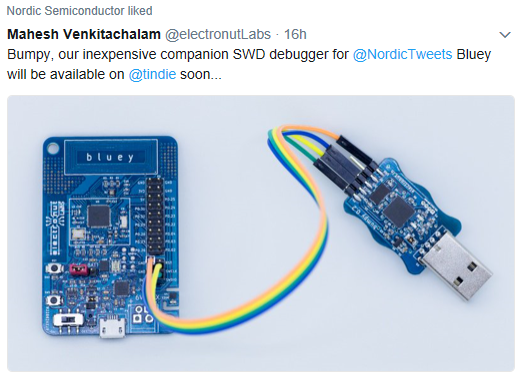nRF5 action!
-
@Nca78 said in Minimalist SAMD21 TQFP32 Pro Mini:
Has anyone noticed that a bunch of cheap Chinese "smart bands" use a nrf51822 ?
Yes. There are people working with it. Please read the discussion at github. There are watches with non nordic chips.
https://github.com/sandeepmistry/arduino-nRF5/issues/165
There are a lot of other hardware like the Noke Lock
Or the iStubb 2 with integrated stop up converter (maybe inductor + software) which works with 0.9V.
-
@d00616
Fortunately, I just received the J-link segger from aliexpress. When I plug it in, Windows seems to immediately recognize it. However, the problem is that the Arduino IDE doesn't seem to recognize it: it doesn't show up in the IDE port list under the tools menu.I've tried installing each of the Zadig usb drivers, in turn, with no difference.
I tried installing the mbed usb windows driver, but it fails with the same error message as before.
I also tried downloading the segger software pack and installing it. Still fails.
Frustrating!
-
@NeverDie said in Minimalist SAMD21 TQFP32 Pro Mini:
I've tried installing each of the Zadig usb drivers, in turn, with no difference.
You have to remove the J-Link software completely. With my old j-link I had to install the J-Link software for Firmwareupdate. After that I removed the J-Link Software and all drivers via "device manager" (module plugged in) and reinstalled the correct driver with zadig (plugin module after starting zadig).
-
@d00616
OK, I'll try that. Which of those 4 Zadig usb drivers should I pick?
-
@NeverDie said in Minimalist SAMD21 TQFP32 Pro Mini:
OK, I'll try that. Which of those 4 Zadig usb drivers should I pick?
Open the windows device manager and pull/plug the device and remove all depending drivers with option to uninstall the drivers.
-
@d00616
Right. But after that, which of the four do I re-install from Zadig? Or, am I misunderstanding?
-
@Nca78 said in Minimalist SAMD21 TQFP32 Pro Mini:
Has anyone noticed that a bunch of cheap Chinese "smart bands" use a nrf51822 ?
This opens some new possibilities if used as MySensors actuator !
https://www.youtube.com/watch?v=SBHyQ1OSM-4
-
this one with nodic 52832
-
next nice board with NRF 52832
-
@NeverDie said in Minimalist SAMD21 TQFP32 Pro Mini:
Right. But after that, which of the four do I re-install from Zadig? Or, am I misunderstanding?
The CDC and BULK interface. All other are other Hardware.
-
FWIW, I ran across another example of where someone is using the DK to program an external nRF5 board:

(https://github.com/electronut/ElectronutLabs-bluey/blob/master/nRF52-DK-prog.md)
Unfortunately, that photo is also roughly the extent of their documentation, though they do spell out the pin mapping and tell which Linux commands to use.
-
I tried wiring it up as shown in the photos to the Adafruit nRF52832 and doing a programming through the DK and the Arduino IDE, but as you would expect it just programmed the nRF52832 that's on the DK and not the Adafruit. So, either there's a jumper that needs to be set, or different software is required to program an off-board nRF52832.
-
Well, I found this in the user manual of the DK, which sounds quite encouraging:
The nRF52 Development Kit board supports programming and debugging nRF51 and nRF52 devices mounted on external boards. To debug an external board with SEGGER J-Link OB IF, connect to the Debug out connector (P19) with a 10 pin cable. Figure 22: Debug output connector
When the external board is powered, the interface MCU will detect the supply voltage of the board and program/debug the target chip on the external board instead of the on-board nRF52832.
Important: The voltage supported by external debugging/programming is 3.0 V.
You can also use P20 as a debug out connection to program shield mounted targets. For the Debug out header (P19),the Interface MCU will detect the supply voltage on the mounted shield and program/debug the shield target.So, I'll try powering the off-board nrf52832 separately and see if it then works as described.
-
Success! Got Blink compiled and uploaded to the Adafruit nRF52832 Feather using the nRF52832 DK.
BTW, the adafruit LED works the opposite of the DK LED: on the Adafruit (as with most Arduino's), LOW means OFF, and HIGH means ON. For some reason the DK is the opposite of that.
-
Here is a photo to document the solution which worked:
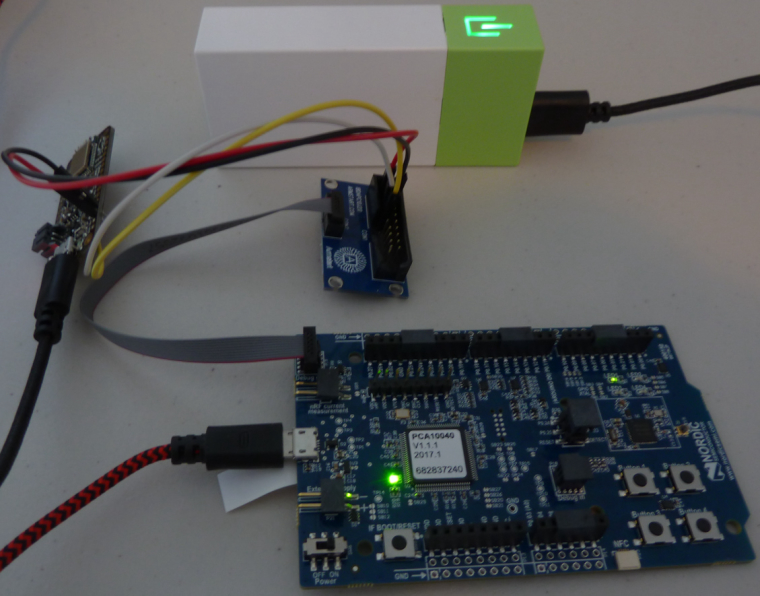
For some reason the wiring shown in the Sparkfun and Bluey photos using header P20 didn't work for me, but using the ten pin P19 header, in combination with externally powering the Adafruit nRF52832 Feather, did work. So far, this is the only solution I've found which works from the Microsoft Windows environment using the Arduino IDE. So, this is what I'm going to move forward with.
So far, this is the only solution I've found which works from the Microsoft Windows environment using the Arduino IDE. So, this is what I'm going to move forward with.
-
So, I have the Mysensors Light Sensor demo sketch running now on the Adafruit. I'm sorry to report though that the range is not good. Not sure why. Maybe it's that chip antenna Adafruit is using on its nRF52 Feather? Now that I know this, I won't be buying any more of them.
-
@NeverDie Good work, I am glad you have successfully programmed a chip from the DK.
Do you think we should open a new thread devoted to all of this Bluetooth action?
-
@Terrence said in Bluetooth action!:
@NeverDie Good work, I am glad you have successfully programmed a chip from the DK.
Do you think we should open a new thread devoted to all of this Bluetooth action?
Meh, I'll leave that up to the moderator. Meanwhile, I changed this thread's title to match your catch phrase.
-
@MiKa said in nRF5 Bluetooth action!:
next nice board with NRF 52832
Thanks for your post! Looks as though they have some very nice tutorials to go with it. That really sets it apart and makes it much more desirable.
Perhaps most significant of all: it claims it can be "programmed and debugged wirelessly"! Well, that makes sense, given the nature of its language.
-
@NeverDie said in nRF5 Bluetooth action!:
BTW, the adafruit LED works the opposite of the DK LED: on the Adafruit (as with most Arduino's), LOW means OFF, and HIGH means ON. For some reason the DK is the opposite of that.
Maybe it is like the esp32 that the led is connected to vcc and not to gnd
-
@NeverDie said in nRF5 Bluetooth action!:
Meanwhile, I changed this thread's title to match your catch phrase
Perfect.
-
Looks as though the nRF52832 sparkfun board has more of a conventional trace antenna:
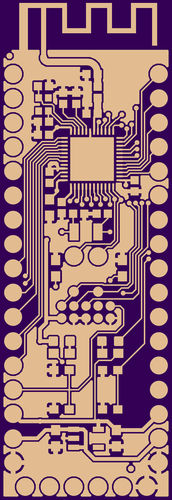
though isn't it somewhat odd that it appears to also be directly connected to the ground plane(?), or at least a copper pour. Is that normal? This was one of the images produced by sending their .BRD file to oshpark, so that I could get a look at the antenna.
-
Please, take a look at the Soc version, only 3,33,10,5 ... Ok it is a Soc version ...
but unbelievable ....
BR
JP
Same question for WIFI bgn and bng/ac ... including a low power CortexM4F also ?
-
@jpb said in nRF5 Bluetooth action!:
Please, take a look at the Soc version, only 3,33,10,5 ... Ok it is a Soc version ...
but unbelievable ....
BR
JP
Same question for WIFI bgn and bng/ac ... including a low power CortexM4F also ?@jpb
Nice, but for present purposes the problem is that it doesn't use a Nordic nRF5. The existing mysensors development release doesn't support bluetooth per se, but rather the nRF24-type modes of the nRF5 chip. A chip from a non-Nordic chip manufacturer wouldn't support those modes.What will be interesting is if/when mysensors does in some way support bluetooth proper, at which point maybe some kinds (?) of bluetooth interactions with non-nordic bluetooth devices may be possible. Nordic has a bluetooth stack available for use on its nRF5 chips, and so it's ripe for integration.
-
For people who like coincell motes, this type of PCB design should be easy to put together:
https://www.aliexpress.com/item/iBeacon-Module-Bluetooth-4-0-BLE-Support-Near-field-Positioning-Sensor-Wireless-Acquisition/2049663760.html?spm=2114.search0104.3.32.DOxJ8e&ws_ab_test=searchweb0_0,searchweb201602_4_10152_10065_10151_10068_10130_10084_10083_10080_10082_10081_10110_10178_10137_10111_10060_10112_10113_10155_10114_10154_438_10056_10055_10054_10182_10059_100031_10099_10078_10079_10103_10073_10102_5360020_10189_10052_10053_10142_10107_10050_10051-normal#cfs,searchweb201603_1,ppcSwitch_4&btsid=4fa0fbcf-4595-46be-bd67-15faeeec2be5&algo_expid=f9915ec2-6be8-4ffb-aa7c-5da25d04f4a1-4&algo_pvid=f9915ec2-6be8-4ffb-aa7c-5da25d04f4a1
-
I have some of these 1.27mm 10 pin box connectors on order from Aliexpress (above), but I'm ordering a few more from Digikey so I can get them faster:
https://www.digikey.com/product-detail/en/3220-10-0100-00/1175-1627-ND/3883661
It should make wire-ups for chip programming/debugging a lot easier.Of course, I'd most prefer to do it all wirelessly.... Has anyone reading this had any success with that, or know of anyone who has without resorting to espruino?
-
If we upload to an nRF52840 the current mysensors demo code examples for an nRF52832, will it work? Anyone tried it?
-
@NeverDie said in nRF5 Bluetooth action!:
If we upload to an nRF52840 the current mysensors demo code examples for an nRF52832, will it work? Anyone tried it?
The 52840 is currently unsupported:
https://github.com/sandeepmistry/arduino-nRF5/issues/70You can try the source code from: https://github.com/lpercifield/arduino-nRF5/tree/nrf52840
-
In that case I think I may order another nRF52832 DK, because I want to establish very soon some kind of reasonable baseline for the kind of range I should expect. The adafruit nRF52832 Feather seems to have awful range, and I'm not sure if that's what I should expect generally, or whether it's just that particular design/device. If it turns out to be true for nRF52832 generally, then I may just shelve things and wait for the nRF52840 to become supported and then try again with that.
-
-
I found I could improve reception from the Adafruit nRF52832 Feather by using an PA+LNA boosted nRF24L01. So, although this feels a bit like a step backward, it's at least workable and fairly cheap. Also, it need only go onto a gateway, thereby allowing other motes to potentially use smaller nRF5 modules.

-
I have this on order to serve the purpose:
https://www.aliexpress.com/item/E01-ML01DP5-Ebyte-2-4GHz-20dBm-2100m-nRF24L01-SPI-Wireless-transceiver-module/32638720689.html
though yesterday I tested the idea using one of these:
https://www.aliexpress.com/item/Smart-Electronics-1Set-2-4G-1100-Meters-Long-Distance-NRF24L01-PA-LNA-Wireless-Transceiver-Communication-Modules/32707423150.html?spm=2114.search0204.3.105.TGUiz5&ws_ab_test=searchweb0_0,searchweb201602_4_10152_10065_10151_10068_10130_10084_10083_10080_10082_10081_10110_10178_10137_10111_10060_10112_10113_10155_10114_10154_438_10056_10055_10054_10182_10059_100031_10099_10078_10079_10103_10073_10102_5360020_10189_10052_10053_10142_10107_10050_10051-10111,searchweb201603_5,ppcSwitch_4_ppcChannel&btsid=a7086a85-885c-430a-a6db-e8f80171efc1&algo_expid=959e3532-756a-47c5-8de7-461b096da1d9-10&algo_pvid=959e3532-756a-47c5-8de7-461b096da1d9
-
Here's a demo of the high speed feature of nRF52 on a Samsung S8 phone:
https://devzone.nordicsemi.com/blogs/1106/bluetooth-5-2mbps-demo-with-nrf52-series-and-samsu/It occurs to me now how much more interesting this will get when phones later have the nRF52840 in them and can do long range bluetooth communication.
-
@NeverDie >>1100-Meters Long-Distance
That would be impressive.
-
-
Maybe @sundberg84 could take inspiration for his easy pcb

-
how'd you program this blank nrf52832 chip with an SWD programmer like the ST link v2 what programming environment to use and so on?
-
@Mike_Lemo
I had no luck using the ST link v2 from Windows. You might be luckier, or you might try using it from Linux. However, as discussed above, I have had success using the nRF52832 DK and the Arduino IDE from Windows. That's how I intend to program the nRF52832 module using the breakout board I posted above.
-
I used the Arduino IDE with sandeepmistry arduino core installed and I managed to program a nrf51822 module with success. I used a cheap st-link programmer from AliExpress. I don't know about nrf52832 as I don't have one. But I don't see why it wouldn't work. You need 4 wires: Vdd(3.3V), GND, SWD and SWCLK.
From Arduino IDE you need to select st-link as programmer.
It uses openocd under the hood to do the work and it worked both on Windows and Linux. On Linux you might need to set udev rules for allowing regular user to use the st-link.
-
@mtiutiu said in nRF5 Bluetooth action!:
I managed to program a nrf51822 module with success.
Did you power the nrf51822 through the st-link programmer, or did you power it independently?
-
@mtiutiu And when you want to program an independent chip with the ST link V2 do you just chose "generic nrf52"?
Also how is it possible to connect between through two NRF52s in slave master config?
Is it possible to take advantage of the NFC functionality with that programming environment?
-
Good news! I received my second nRF52832 DK today, so now I can have a DK on both ends of a link. Bottom line: I ran some quick tests, and it has much better range than the Adafruit nRF52832 Feather.
Whew! What a relief. The Adafruit had very disappointing range. In contrast, and as expected, the two DK's have better range than regular nRF24L01+ radios.
-
@NeverDie How did you manage to send and receive data between these two units? may you share the code with us?
-
@Mike_Lemo
I'm simply using the GatewaySerial and the LightSensor sketches from the mysensors developers release. Just make the following change in each sketch://#define MY_RADIO_NRF24 #define MY_RADIO_NRF5_ESB
-
Powered from st-link programmer.
-
I used generic and no soft device as Mysensors doesn't use soft devices. I don't know about master-slave, didn't used such a configuration.
You need to create another variant for other pin definitions as this is the way arduino framework works as far as I know.
Never used NFC so I can't give you hints on that, sorry.
-
Looks as though these guys came up with a fairly easy way to develop using actual bluetooth low energy: http://mklec.com/project-kits/kd-circuits/bluetooth-low-energy-board-anaren-A20737-module
Unfortunately, I don't believe it runs on the nRF5 though.
-
More good news! I was able to program a Sparkfun nrf52832 board using the DK, and its range is better than the Adafruit nRF52832 Feather and also better than an nRF24L01+.
So, my provisional conclusion is to avoid chip antennas, such as Adafruit is using, if better range is desired.
@NeverDie said in nRF5 Bluetooth action!:
Looks as though the nRF52832 sparkfun board has more of a conventional trace antenna:

though isn't it somewhat odd that it appears to also be directly connected to the ground plane(?), or at least a copper pour. Is that normal? This was one of the images produced by sending their .BRD file to oshpark, so that I could get a look at the antenna.Also, this now gives me a "known good" platform, namely the Sparkfun nRF52832 board, to order PCB's for and try to see if I can successfully solder on any of the bonus nRF52832 chips I received with my two DK's.
-
Apparently you can now run micropython on an nRF52832 board:
MicroPython nRF52 Firmware Compile & Flash with Tony D! – 1:11:04
— Adafruit IndustriesIt's still early days, but it sounds like fun. For one thing, since it's a dynamic language, OTA updates should be easy!
-
@NeverDie Wow, that it really good news. I was following Tony's videos on mpy on the ESP chips, but had not checked back lately.
-
@Nca78 said in nRF5 Bluetooth action!:
For shipment delay I wouldn't be surprised if they shipped the same way with free option and it would just be a different way to state the delay on the 2 websites...
You were right: I received both the ebay and the aliexpress packages today. Even for e-packet, that's pretty fast shipping! In fact, they arrived before any of the other items I ordered from other vendors. So, at least that part went well.
-
Does the E73-2G4M04S require anything extra in order to be programmed?
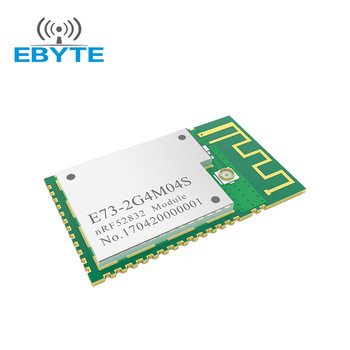
Today I tried programming it the same way that I have successfully with both the adafruit and the Sparkfun nRF52832 boards using the DK, but the DK keeps complaining that the E73-2G4M04S may not be connected.
-
@NeverDie if I remember well in the datasheet they say you have to put the softdevice on it first.
-
Yeah, here's what it says:
- The module embedded with ARM MCU. For program downloading, please use the J-LINK downloader, any other serial port or JTAG、ISP、ICP are
unavailable to download. - There’s two parts to download the program. Because the protocol stack
of NORDIC is not programmed yet, so users need to use the official nRFgo
studio of NORDIC to program the protocol stack first, then program the hex of application code. Or, to program the protocol stack of NORDIC first and
download via the IAR or KEIL.
Seems odd, but I'll give it a try.
- The module embedded with ARM MCU. For program downloading, please use the J-LINK downloader, any other serial port or JTAG、ISP、ICP are
-
It's not clear whether the DK can/should be used for this part of it, as it's unclear (at least to me) whether it will end up altering the target chip or the DK. I'm just not sure. So, to do at least this ambiguous part of it, I'll first check whether or not the nRFgo studio software will work with one of the other programmers I've collected (not the DK). That may take a while...
-
Why don't you try to program it with a st-link programmer and arduino ide with sandeepmistry nrf5 core installed? I bought that module(E73-2G4M04S) too and I want to know how this part goes. Thanks.
-
@Nca78 said in nRF5 Bluetooth action!:
@NeverDie if I remember well in the datasheet they say you have to put the softdevice on it first.
@NeverDie
you need to do this if you're using ble, it's the nordic stack running ble etc behind the scene.
For using nrf52 with MySensors, you don't need to do this. Also, MySensors & the softdevice can't run at the same time for the moment afaik.this module should work like others module, by following nrf52 datasheet.
looking at their datasheet, you maybe could add (i don't know if it's already onboard):- 100pf on DEC2
- 0.1uf on DEC1 (but they have no DEC1 1) it's already onboard, 2) there is a typo error on their datasheet ?? as DEC5 doesn't exist on nrf52)
- decoupling power
then it's just a matter of swd programming (3v,gnd,DIO,CLK)
You can take a look at nordic datasheet, or adafruit howtos are nice too.
-
@scalz said in nRF5 Bluetooth action!:
- 0.1uf on DEC1 (but they have no DEC1 1) it's already onboard, 2) there is a typo error on their datasheet ?? as DEC5 doesn't exist on nrf52)
Great catch! Based in part on proximity to the DEC1 pins in the Ebyte datasheet, I'm guessing you've nailed it and that "DEC5" is actually DEC1.
Here's Nordic's pinout:
For other readers'convenience, here is a link (courtesy of NCA78) to Ebyte's datasheet:
https://forum.mysensors.org/assets/uploads/files/1499826952956-e73-2g4m04s_datasheet_en_v1.1.pdfBesides, as you point out, there is no actual DEC5 according to the Nordic pinout, so what else could "DEC5" be?
I've just now emailed the seller to ask this question, but for now I'll assume you've nailed it. Great work!
-
Seems as though we're somewhat shooting in the dark, though, without a schematic of what Ebyte actually did on the module. For instance, I had assumed that all this (plus whatever else is needed) had already been implemented on the Ebyte module. Relative to the Nordic nRF52832 chip size, the Ebyte moduile is already a pretty big module!
-
I'm tring to blink an led on a PCB I made not realy knowing how to program the IC before other than connection the SWD pins.
I've followed the startup guide at github flashed the soft device probably successful using the ST link V2(while flashing the soft device it blinked the on board st link V2 led and at the end the blue led on my PCB stopped being on.)
So I've got an RGB led connected to my PCB to pins:
#define RGBL_RED_PIN P0.16
#define RGBL_GREEN_PIN P0.15
#define RGBL_BLUE_PIN P0.17now for a test to see if I got it right I want to blink each of them how would I do it?
What is the arduino pin mapping?
-
@NeverDie said in nRF5 Bluetooth action!:
Seems as though we're somewhat shooting in the dark, though, without a schematic of what Ebyte actually did on the module.
On the other hand, I suppose if Ebyte had already decoupled DEC1 and DEC2 with caps on their module, there'd be no point in exposing those pins. So, I guess by inference, they must not already be decoupled. Is that the idea?
-
@Mike_Lemo said in nRF5 Bluetooth action!:
I'm tring to blink an led on a PCB I made not realy knowing how to program the IC before other than connection the SWD pins.
I've followed the startup guide at github flashed the soft device probably successful using the ST link V2(while flashing the soft device it blinked the on board st link V2 led and at the end the blue led on my PCB stopped being on.)
So I've got an RGB led connected to my PCB to pins:
#define RGBL_RED_PIN P0.16
#define RGBL_GREEN_PIN P0.15
#define RGBL_BLUE_PIN P0.17now for a test to see if I got it right I want to blink each of them how would I do it?
What is the arduino pin mapping?
Isn't the arduino mapping generally handled by the boards.txt file? Which board that you're using are you telling the compiler that it is? i.e. which board under the board manager in the Arduino IDE are you selecting?
-
Actually never mind I got it just removed the P0. and put the number for example if I want to flash P0.16 I do 16 and it works!!
Feels so good to understand that I can now finish my big project now all I have to figure out it how to use NFC and connect it to another NRF52832 device!Here's a demo:
https://www.youtube.com/watch?v=hCMKsORq2sM&feature=youtu.be
-
Oh yeah and forgot to mention I used the generic NRF52 settings.
-
Aha! I just now noticed that on the silk screen for the actual module itself, it does indeed say DEC1, not DEC5, in what would otherwise be the DEC5 location. So, that settles it. "DEC5" really is DEC1, and "DEC5" is just a typo in the datasheet.

-
you should follow this schematic design if you want to get this module working.
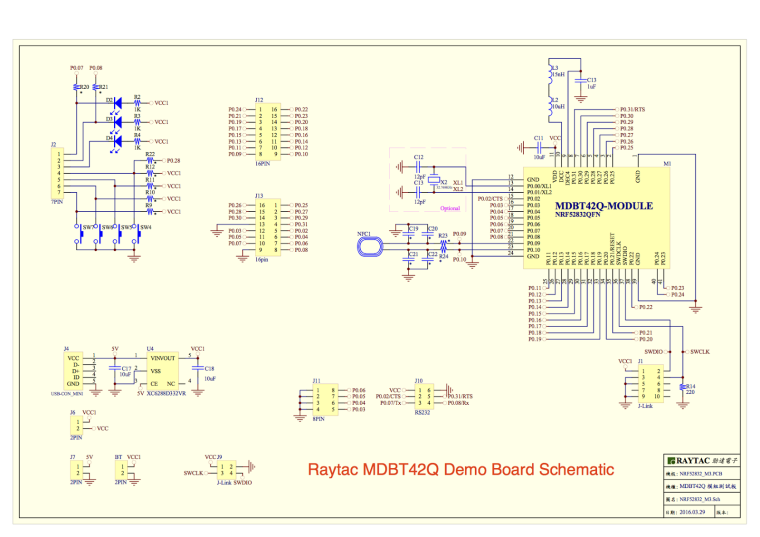
-
@Mike_Lemo said in nRF5 Bluetooth action!:
Oh yeah and forgot to mention I used the generic NRF52 settings.
The "generic" settings haven't a good pin assignment. Pins P0.00 and P0.01 are reserved for the 32KHz crystal and defined as TX/RX pins. That's an conflict.
-
@d00616 said in nRF5 Bluetooth action!:
@Mike_Lemo said in nRF5 Bluetooth action!:
Oh yeah and forgot to mention I used the generic NRF52 settings.
The "generic" settings haven't a good pin assignment. Pins P0.00 and P0.01 are reserved for the 32KHz crystal and defined as TX/RX pins. That's an conflict.
What should we use instead?
-
@NeverDie The "Taida Century nRF52 minidev" has a lot of pins mapped out:
https://github.com/RIOT-OS/RIOT/wiki/Board%3A-nRF52-minidev you can select the programmer like your needs. The RedBear BLE Blend 2 has also a lot of pins mapped out, but the CMSIS-DAP is preselected.
-
@d00616 It says there NFC is not useable but what if my board is NFC hardware ready? how would I use that?
-
@Mike_Lemo said in nRF5 Bluetooth action!:
@d00616 It says there NFC is not useable but what if my board is NFC hardware ready? how would I use that?
It's simple. Use that. NFC isn't enabled or disabled by the board definition. Without SoftDevice, you have to enable the NFC functionality by flashing into the UICR.
You can define your own Board. Look into the "boards.txt" file and the "variants" folder in ~/.arduino15/packages/sandeepmistry/hardware/nRF5/0.3.0/ Most pins can be assigned to roles like SPI, I2C, UART.... Pins like NFC, RESET are fixed and analog Pins an be ordered like your needs.
-
@NeverDie where can that boards.txt file of the NRF52 thing be found?
-
@d00616 I meant is there a library or something for that? how do I approach it I'm relatively new for this 3rd party arduino programming thing and I'ts necessary for me sins I already made a PCB for a micro controller I want to use.
-
@Mike_Lemo said in nRF5 Bluetooth action!:
@NeverDie where can that boards.txt file of the NRF52 thing be found?
On the Windows platform it's located in this directory: Program Files/Arduino/hardware/arduino/avr
-
@NeverDie I can't see the Generic nrf52 board setting
-
I added the two caps that Scalz suggested for DEC1 and DEC2, but I'm still getting the same error message as before when I try to program it using the DK. Unless someone has further ideas, I may have to wait two weeks for my breakout board to arrive before I do more, as right now I'm just deadbugging this by soldering wires directly to the module.
-
@Mike_Lemo said in nRF5 Bluetooth action!:
@NeverDie I can't see the Generic nrf52 board setting
That's all I know, so hopefully someone who knows more can chime in and offer you guidance.
-
BTW, here's a picture of how the silkscreen looks and which shows DEC1 in the "DEC5" location:

-
@NeverDie said in nRF5 Bluetooth action!:
@Mike_Lemo said in nRF5 Bluetooth action!:
@NeverDie I can't see the Generic nrf52 board setting
That's all I know, so hopefully someone who knows more can chime in and offer you guidance.
Oh, I see now that @d00616 already has. Sorry, my browser didn't refresh, so I missed seeing his post.
-
Yeah he did I just preformed a local search for that arduino15 on my PC
-
Also If I want to change the UART pins to other pins would it work without errors or If I want to use 2 or more UARTS? same with I2C
Also what are the debugging options available sins the RS232 is not connected to the MCU like in an arduino how would I set stop points or peek at variables values to see if the code runs as expected?
-
@Mike_Lemo said in nRF5 Bluetooth action!:
you should follow this schematic design if you want to get this module working.

There's a bunch of similar looking schematics in the nRF52832 datasheet for the nRF52832 chip itself, but I'm not sure which of them, if any, is applicable to the Ebyte module. I guess maybe Ebyte needs a demo board schematic like Raytac has. Either that, or we need a schematic of what's on the Ebyte module itself. As it stands, I think maybe there's no enough info with which to move ahead on wiring up the Ebyte module. Am I wrong? Come to think of it, I think some of the other Chinese modules I ordered from Aliexpress may also be similar "mystery" modules.

-
@Mike_Lemo said in nRF5 Bluetooth action!:
Also If I want to change the UART pins to other pins would it work without errors or If I want to use 2 or more UARTS? same with I2C
The Chip has a lot of periphery on it. You can connect most components to pins. There is only one hardware UART, which can be connected. Please look at the Infocenter The arduino-nrf5 port is limited to things are implemented with arduino-samd by the author. This is the reason I have implemented an extension for hwPinMode() in MySensors.
Another fine thing is the implementation of Shortcuts and the PPI. You can do a lot without using the CPU.
@Mike_Lemo said in nRF5 Bluetooth action!:
Also what are the debugging options available sins the RS232 is not connected to the MCU like in an arduino how would I set stop points or peek at variables values to see if the code runs as expected?
Debugging depends on your programmer and flashing tool. I think you can start by search for "openocd gdb". OpenOCD is the flashing tool in arduino-nrf5 for all supported programmers.
-
It looks as though raytec does make two modules for the nRF52832 that has a PCB antenna rather than a chip antenna: the MDBT42Q-P and the MDBT-42V-P:
http://statics3.seeedstudio.com/assets/file/bazaar/product/MDBT42Q-Version_B.pdf
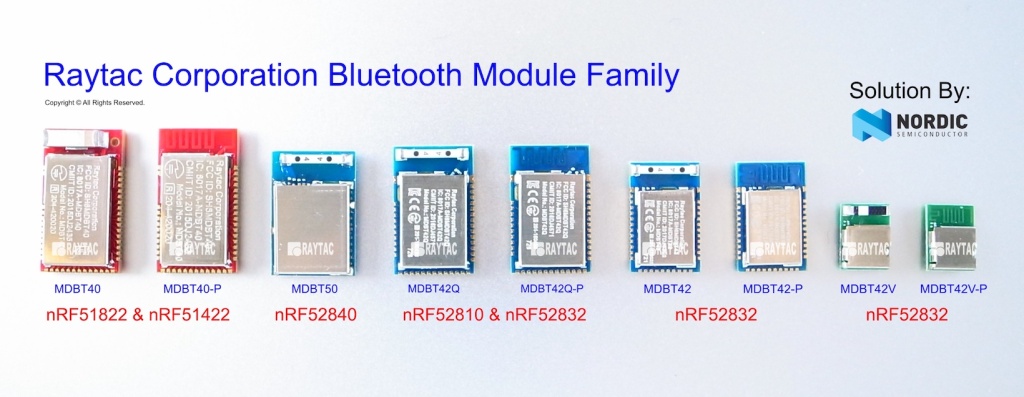
The MDBT-42V-P looks nice because of its small size. Anyone know where it can be purchased? All of a sudden, buying a module that comes with a proper datasheet seems appealing.
-
@NeverDie I had mine from seeed studio
-
@Mike_Lemo said in nRF5 Bluetooth action!:
@NeverDie I had mine from seeed studio
This one? https://www.seeedstudio.com/MDBT42Q-nRF52832-based-BLE-module-p-2736.html
-
I was just now noticing that Nordic has a very convenient list of third party modules (and their dimensions) that use the Nordic nRF52832 chips: https://www.nordicsemi.com/eng/Products/3rd-Party-Bluetooth-low-energy-Modules
-
FWIW, I just now sent an email to support@cdebyte.com requesting either a schematic of their E73-2G4M04S module itself or a schematic for a demo circuit, so that I may be certain about adding the appropriate hardware needed to get their module to work. I'll post if I hear anything back from them.
By the way, in the case of Raytac, they even have their own demo board: https://raytac.blog/2017/01/24/how-to-use-raytac-mdbt42q-nordic-nrf52832-demo-board/
-
I saw this in the MDBT42Q module datasheet, and perhaps it explains the relatively poor performance of the nRF52832 Adafruit Feather which uses the MDBT42Q.:
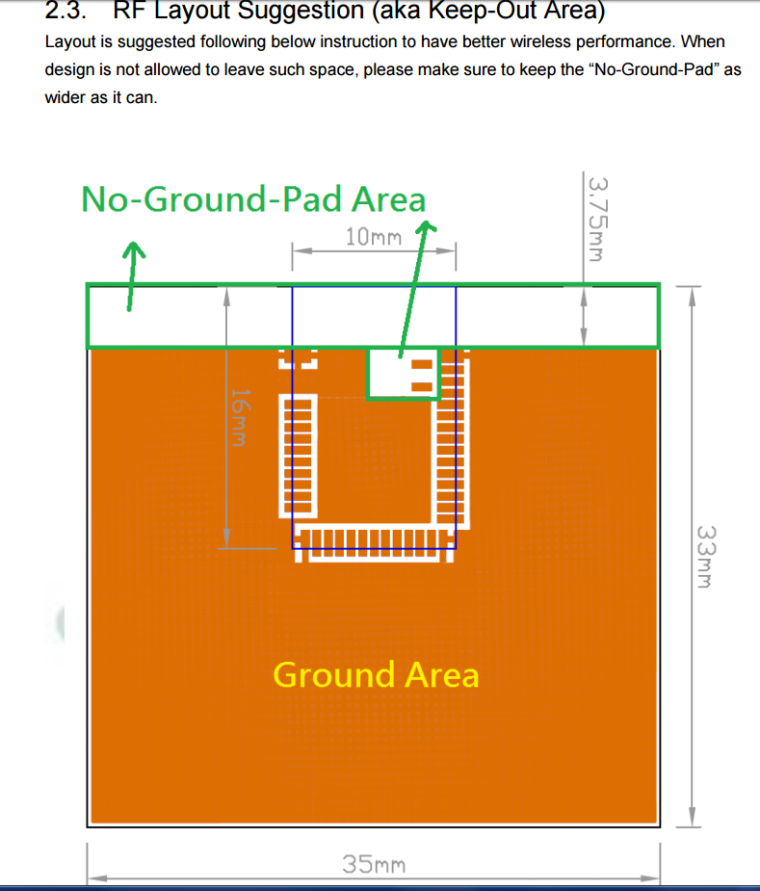
I believe the Adafruit may have a much smaller ground plane than what is being recommended here by Raytac.
-
I requested the schematic for the cdebyte module too...but they replied: it's confidential - LOL.
-
@mtiutiu
How long did it take them to reply to you?I guess we may have to reverse engineer what they did then--at least roughly--in order to use it. I'll see if I can pry the cover off and photograph what's inside. If I'm successful, then I'll post the photos so we can all look at it together.
-
About 6 hours. I asked them too if the Nordic datasheet recommendations were followed or not and if they can provide an example of how to use the module.
-
@mtiutiu said in nRF5 Bluetooth action!:
if they can provide an example of how to use the module
What was their answer to that, or is it still pending? I don't mind them being a black box, provided they show how to use it.
-
@mtiutiu said in nRF5 Bluetooth action!:
I requested the schematic for the cdebyte module too...but they replied: it's confidential - LOL.
this one is funny, like if there was something special in their module

-
@NeverDie
Didn't replied yet. When I get an answer I'll post it here so no worries.
-
Here's a photo with the lid pried off:
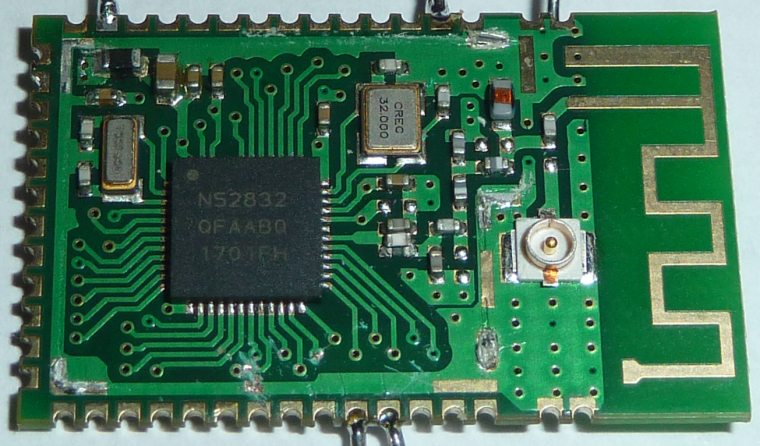
Maybe we can reconstruct what's going on just from looking at the components and the trace lines? At least for now, I'm not so concerned with the RF part.
-
Here's a photo taken from the opposite angle:
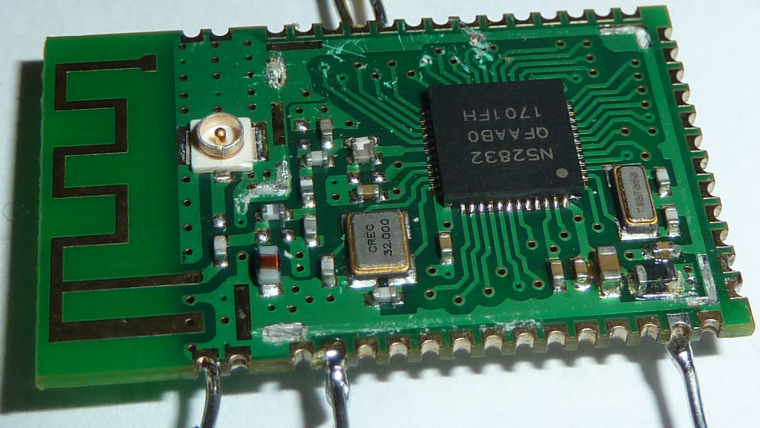
Any other photos anyone wants to see?
-
Here's the back:
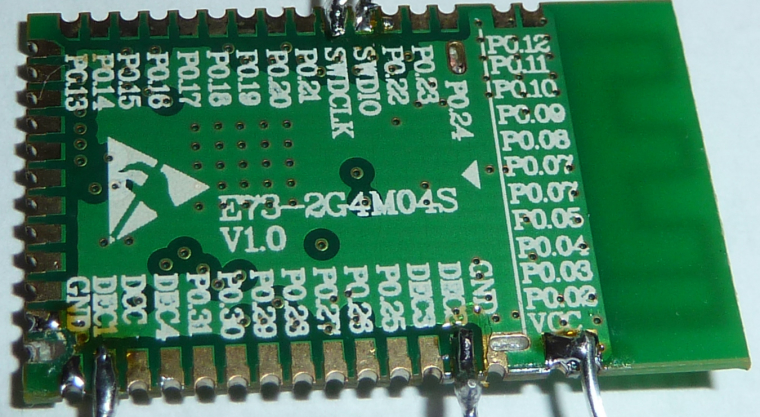
So, is it 4 layer as they claim, or only 2? Some of those vias seem rather pointless if it were only 2 layer.
-
So, to Scalz's earlier point, it looks like indeed there is no capacitor already on DEC1. Regarding DEC2, it appears that there are pads and solder paste for a capacitor, but the capacitor appears to be missing! Manufacturing error?
-
@NeverDie
cool. well you just have to check continuity.
Yes this a 4layers. better for compact RF imho, else worse performance, EMI etc.. I think it's also easier to get FCC with 4layers design (not sure if this module is FCC though)My bad, i've just reread what i wrote. With nrf52 ic, I've rechecked, I'm using:
- DEC1: 100nf
- DEC2: nothing
- DEC3: 100pf
- DEC4: 1uF (and you add inductors with DCC, for DC/DC mode but it can decrease 1dB if i remember well)
Suggested Topics
-
Welcome
Announcements • • hek
